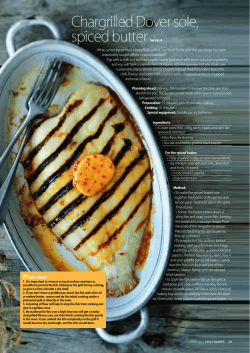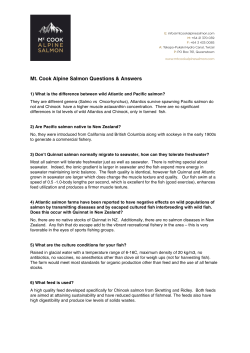
The Benefits of Fish
The Benefits of Fish Fish is a protein-rich food that is healthy for both children and adults. Besides being low in saturated fat, fish also contains a good type of fat (omega-3 fatty acids) and nutrients such as Vitamin D.(1)(3) For Moms and Children While fish in general may be a healthy food, certain fish can contain high levels of mercury which can have a serious effect on an unborn or young child’s developing nervous system (1)(3). Avoiding fish that are high in mercury is important for young children and pregnant or breastfeeding women. (1)(2)(3). Don’t Eat… Avoid these fish that are high in Mercury (2): Swordfish Shark Bluefish* King Mackerel Walleye (Great Lakes) Striped Bass* Tilefish (Gulf of Mexico) Spanish Mackerel (Gulf of Mexico) Orange Roughy Tuna (fresh or frozen) *These fish are known to contain high levels of PCB’s (Polychlorinated biphenyls) Amounts to Eat For pregnant and breastfeeding women, the 2010 Dietary Guidelines recommend at least 8 and up to 12 ounces per week of cooked seafood considered to be low or moderate in mercury. Young children should eat less than 8 ounces per week of cooked fish in the lowest mercury category (1)(3). Do Eat… These fish and shellfish are considered the lowest in mercury (2): WIC Fully Breastfeeding Food Package Catfish (farm raised) Pollock White Fish Light tuna (can or pouch) Flounder Sole Herring Tilapia Sardines Haddock Cod Scallops Squid Salmon (can or pouch) Rainbow Trout Mackerel (farm raised) (Atlantic, Jack, Chub) Salmon (fresh or frozen)(wild or farm raised) Shrimp Clams Crab Oysters (cooked) Eat in Moderation… These fish and shellfish contain higher levels of mercury and should be limited to not more than 4 ounces per week (2): Albacore (“white”) tuna has more mercury than canned light tuna. Carp Black Bass Halibut Mahi Mahi (Dolphin-fish) Lobster Snapper “Local Catch” Alert You cannot tell how contaminated a fish is by looking at the water in which it swims. Some fish caught in very clean looking water may be highly contaminated. The safest way is to check the local fish advisories for the area that you or your family fish. Purdue University’s Fish for Your Health website http://fn.cfs.purdue.edu/fish4health/ can provide a fish advisory for your area (2). Cooking Fish Pregnant women, infants and young children are at risk for food borne illness caused by various foods including raw oysters and raw fish (sushi). Fish should be cooked to an internal temperature of 145ºF. Cooked fish and shellfish should be milky white (opaque); fish should flake with a fork (1). 1. 2. 3. Dietary Guidelines for Americans, 2010, Policy Document, Chapters 4 & 5, Appendixes 3 & 11 (January 2011) Fish for Your Health, Advice for Pregnant, Nursing Women, Women Who May Become Pregnant & Children (2-6 yrs); Purdue University (2009) “Protecting Your Children from Contaminated Fish”; AAP/Healthy Children (Source: Caring for Your Young Child:0-Age 5;AAP 2009) Indiana WIC Program This institution is an equal opportunity provider 05/2011
© Copyright 2025





















